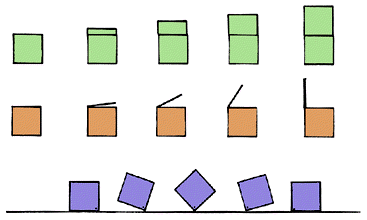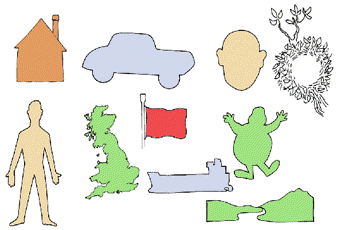Tracing and copying
When you start making sequences of drawings that are similar, it saves a lot of time if you can
copy the part of the drawing that is not changing. The part that changes is called the
Action part, so the rest of the drawing can be copied and only the action part
changed.
For example, here is a box lid opening. Only the lid is moving so having photocopies of the box
without the lid would save a lot of drawing.

Link: Box opening
There are several ways to trace and copy drawings:
| 1. |
The simplest way is to use tracing paper. If you don't have tracing
paper use thin copying paper.
Link: Tracing drawings |
| |
|
| 2. |
You can use normal copying paper if you use black marker pens that
will show through. Ballpoint pens or soft lead pencils also work. |
| |
|
| 3. |
|
You can use proper animation paper cel(cellulose
acetate clear sheet). This is ideal, but requires either a
soft wax pencil or special pens such as overhead projection
pens that will draw on acetate. This paper is quite expensive,
but very useful if you want to trace over a picture from a
book. The cel can then be photocopied to produce an original
page for use with other methods.
Links: Cel animation  Animation glossary Animation glossary |
 |
|
| |
|
| 4. |
You can use an animation lightbox (fig 1), a photographers light
box (fig 2) an overhead projector (fig 3) or any glass or plastic
sheet drawing board that you can shine a light through. Any raised
transparent surface like a sheet of glass or plastic will work as
a light box if faced towards a light source such as the windows. |
| |
|
| 5. |
You can make photocopies of drawing but leaving parts out. For
example a dozen photocopies of a face without the features. Photocopies
are usually dark enough to show through copying paper. It helps
younger children to have part drawings ready-made. Photocopy the
outlines of faces, houses, cars, boats, etc. and let the children
fill in the details. At a later stage, part drawings will be used
as an introduction to animation.

|
| |
|
| |
Link: Colouring pages |
| |
|
| 6. |
Carbon paper is good for copying a drawing. You can do several
copies at the same time. Just trace over the parts that are to remain
the same. For example, a head can be traced over but leave the eyes
and mouth if these 'action' parts are to move. |
| |
|
| 7. |
If you want to use pictures from a book as a starting point, then
photocopy the picture from the book, either trace around the part
you want to copy, or mask out the part you don't want to copy, and
then do a new photocopy of this picture. This can be used. |
|

